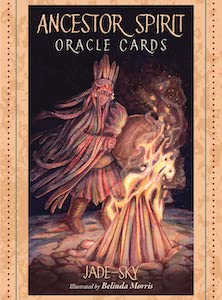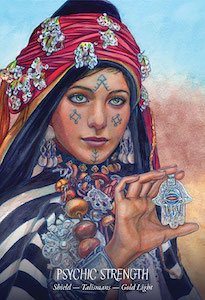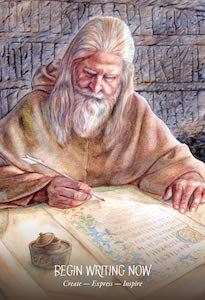
Ancestor Spirit Oracle Cards, by Jade-Sky and illustrated by Belinda Morris
Blue Angel Publishing, 0648746805, 43 cards, 104 pages, May 2021
Opening a new oracle deck is always an exciting experience, as you never know exactly what you’re going to find inside. I’ve used shamanically-themed decks in the past, so I thought I had a rough idea about what I would find inside the Ancestor Spirit Oracle Cards by Jade-Sky and illustrated by Belinda Morris. I was expecting cards themed with different types of elemental energy, sacred sites, and spirit animals, but what I found instead blew me away.
The first thing I saw was the card-backs: a beautiful image of a living bonfire flame dancing on a black background. Very cool. With simply the flames in the midst of darkness, it makes me think that this twisting fire could come from anywhere (or any when) and gives me a sense of connection with anyone who’s ever sat or danced around such a blaze.
When I turned the deck over and started thumbing through the cards, I was surprised to see that each card was designed with people or artifacts from cultures all over the world! Each card depicts a unique group, distinguished by their varieties of clothing, jewelry, architecture, and personal features: from Amazonian tribal groups, to Tibetan monks, to medieval Scotts.

From the get-go, it was clear that Jade-Sky and Morris must have done a ton of research about the vast array of cultures and ethnicities, whether contemporary or historical, that are depicted throughout the deck. The images are packed with detail and, I surmise, meticulously curated to be faithful to the astounding breadth of humanity found within the deck. Of course, I could not always immediately tell what group or culture was on display in the card, but that’s just one of the many incentives to open the guidebook!
In addition to the wonderfully-painted images, each card has a short phrase indicating its meaning (and the name which you’ll use to look up the card in the guidebook), as well as three keywords in a smaller font below. For instance, the card “BEGIN WRITING NOW” has the keywords “Create – Express – Inspire,” while the card “HONOUR THE DEITIES AROUND YOU” has the keywords “Prayers – Offerings – Help.”
There are a couple things that this style of card text does which sets it apart from many other decks you might encounter. First, I love how the card names aren’t just a single word. The short phrases are much more evocative and provide a little more direction for what you can focus on, and do this in a very grounded way. Second, the name and keywords do not dominate the card, allowing for all the beautiful details of the image to speak for themselves. I found this overall card design a delightful mix of aesthetics and guidance.

Opening the guidebook, the Contents section is very straight-forward, with no clutter on the pages and a clear alphabetical list of the 43 card meanings. No need to fuss with a numbering system here! The short introduction provides insight into Jade Sky’s design philosophy, and I particularly like the idea that “Every culture of the world is grounded in its own wisdom, knowledge and tradition.”1 Again, this indicates the depth of research and understanding that went into the design of each card, as the card’s meaning is intimately tied to the wisdom of the depicted culture.
After the brief guidance about how to use these cards and three sample card layouts (consisting of one, three, and seven cards), the guidebook dives right into the card meanings. The entry for each card spans about two pages. A small, black-and-white photo of the card appears at the start of each entry, so you could make your way through the guidebook on its own to get a whole sense of the deck if you wish (though you’d be missing out on all the colorful detail of the actual cards!).
Each card entry also has three sections. First, a description of the culture depicted in the card and why that culture was chosen to be paired with the meaning of the card. This historical and cultural information doesn’t seek to overwhelm you, and gives you a great jumping-off point if you want to proceed to do more in-depth research for yourself.
Yet, these informative sections are still packed with cool tidbits: for instance, “GO WITH THE FLOW” shows Kai Viti (natives of the Fiji islands) sharing Yaqona (kava). The Fijians often share this drink during “island time,” where they just relax, tell stories, and otherwise enjoy one-another’s company. I felt the energy of the card perfectly matched the sense of ease and camaraderie I could see being shared among the people in the scene.

The next section of the card entry, Ancestor’s Speak, is a more direct message about the meaning of your card. What I especially found helpful here was that these ancestors aren’t merely speaking at me – they’re asking questions to provoke me to stop, think, and meditate upon the meaning of the card.
Divinatory Meaning, the final section, encourages you to engage your senses and feelings related to the meaning of the card. Jade-Sky invites you to participate in an activity or pay attention to your environment in a particular way so that you can observe how you are responding in the present moment, or find ways of deepening your connection to the aspects of the world indicated by the card.
What I liked most about the interplay between the two sections (Ancestor’s Speak and Divinatory Meaning) is how one encourages you to listen and learn from the wisdom of the ancestors while the other is focused on spurring you to action – a harmonized blend of receptivity and activity.
Overall, this is an oracle deck I would wholeheartedly recommend to everyone. While some decks can be a little more niche or thematic such that they may not resonate with everyone, Ancestor Spirit Oracle Cards is truly universal because it speaks to the common element of anyone who might pick it up – our humanity. No matter where you live or your cultural heritage, this deck can help you connect to all people from across time and space. The more I use and contemplate the cards, and the deck as a whole, the more I see how wonderfully holistic it is, with every element of the deck playing a role in its unity.

Zak has two master’s degrees in philosophy, from Brandeis University and University of California Santa Barbara. He is currently the lead editor for Dungeons in a Box, and he spends much of his time in the realm of fantasy crafting new plots and ensuring the adventure is in mechanical balance. When he’s not DMing, he also enjoys hiking, studying eastern philosophy, and playing board games.
